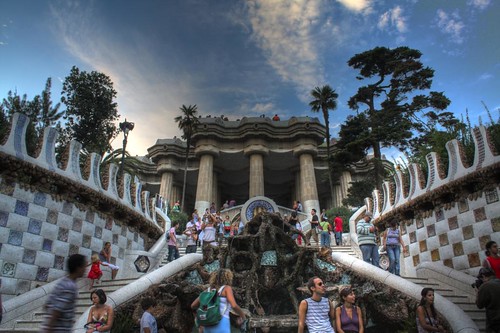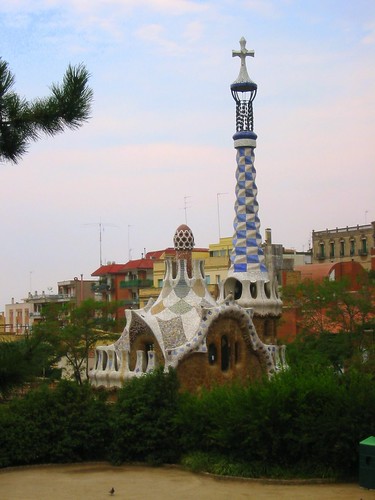Gaudi’s Park Guell in Barcelona
The Park Guell is a park located in one of the slopes of the Caramel Mountain neighborhood in the northern district of Gracia in Barcelona, and is one of the most characteristic works of Gaudí.

Photography by mazlov
In collaboration with Antoni Gaudí and Josep Maria Berenguer Jujol, planned and directed from 1900 to 1914 for Eusebi Guell commissioned the creation of a residential garden city of the British type, scheduled for 60 houses. However, the project was never fully developed, only two houses were built, but it led to the creation of this unique space in 1923 became the property of the municipality of Barcelona.
Details of the Park Güell:
The Park Güell is a large park where one can see all the genius and innovation of Gaudi, who transformed the landscape whilst respecting the existing wild vegetation. So, to save the rugged topography, instead of constructing embankments the Catalan genius was dedicated to creating architectural viaducts and large trees crowned by large stone planters simulating giant palms.
At the main entrance of the park, located on Calle Olot, stand two pavilions that close the wall around the whole enclosure. These facilities house the counseling and administration buildings and plant are oval, raised stone and roofed complex morphology covered with pieces of broken pottery and crowned by tiny domes and a tall tower with a typical helical double cross «Gaudi».
After two entrance pavilions, shows a broad double staircase. In between the two flights of stairs, small spaces are uniting with water games and zoomorphic sculptures, among which there is a multicolored dragon made of broken pottery that has become one of the features of the park.
The staircase leads to a large room known as the Hall of Hundred Columns or pillared hall, which the initial project should have hosted the residential market. Has 84 Doric inspired columns and some steep (no perfectly straight) holding spherical domes. On the roof there are four medallions depicting the four seasons.

Photography by miss karen
About the Hall of Hundred Columns is the Place of Nature, a large circular plaza where wide reaching views over the city. Represents a natural amphitheater and is surrounded by an extraordinary sinuous bench covered with broken pottery that Gaudi made Jujol with the help of a snake, representing more than 150 meters long. The square is unpaved to take advantage of the rain water drained, also follows the square, there is a large terrace with the additional purpose of holding rainwater and move through the columns to a large cistern, beneath the room Hundred Columns. According to original plans, this place should be a Greek theater for religious celebrations.
The park has more than 3km of roads and viaducts that save the slopes. Highlights the way the rosary and the porch of the washer. All items on the steps to the rooms that are observed at the end, represent all the beliefs of Antoni Gaudí, which would summarize his inspiration in nature, their ideologies and religious fervor Catalunya (represented by the upper spaces of the stairs).

Photography by ale3andro
The dragon or salamander that spits water in alchemy represents the fire element and is the mythological element introduced Gaudí, surely inspired by Delphi. In the religious sphere, Gaudí wanted to turn the road crosses the divide between the two levels of the park as a path to spiritual elevation, building a chapel at the summit, which was never built. Entry into the park also wants to inspire as at the entrance to paradise, a utopian garden. The central area of the stairway has three sources, representing the Catalan countries. Catalunya north or France, and southern Catalonia, Spanish. Initially Gaudí, the first source represented the world’s second largest source is the shield of Catalonia and a snake, in allusion to medicine, and the third source, the dragon represents the city of Nimes, which was the city Güell Antoni where he grew up. Above is a bank as Odeon, strategically located to give you the sun during the winter and shade in summer.
As a curiosity, Antoni Gaudí lived in a house in Park Guell, 1906 to 1925, before moving to live in the Holy Family during its construction. Today the house has become a small museum about Gaudi. In 1984 UNESCO declared the Park Güell Heritage.
How to reach the Park Güell?
The Park Güell is not in the best connections of Barcelona, but the bus can access relatively easy, but if you want to visit the Park Güell by subway, be prepared to walk about 20 minutes. The last mile will rise up to the main entrance.
But if you have trouble climbing stairs or walking uphill we suggest you take a taxi or you choose the bus stop close enough. The bus stops near you are 24, 25 or bus.
The nearest metro station is Lesseps of the green line (L3) and from there you should follow the signs to the park.
Park Güell schedules are 10:00 a.m. to 7:00 p.m. and admission is free.
Bon voyage!
Leave a Reply
You must be logged in to post a comment.
Recent Comments